Former Seattle Planning Commissioner Sarah Snider Komppa spent months visiting and comparing 10 North American cities to answer the following questions: What makes dense urban areas attractive to kids and parents? Why do some give up and move to the suburbs? What are the necessary ingredients to support families living downtown? What policy changes do we need to make?
Komppa took the time to answer some questions about what her travels and research in Boston, New York, Brooklyn, Chicago, Denver, Minneapolis, Washington DC, San Francisco, Toronto, and Vancouver BC can teach the Northwest about ingredients for family-friendly cities.
Q: First of all, if I’m someone without kids, why should I read this?
A: Cities that are great for children are great for everybody. Think about what type of transportation system you might want to ride as a young single woman in the city. If it’s safe for a 12-year-old to ride a transit system alone, then it’s probably safe for you. If there’s a neighborhood that’s safe for a ten-year-old to walk across the street and play with his friends and walk home to his apartment building, that park is probably going to be pretty enjoyable for seniors or young professionals in the city.
Taking kids’ needs into account and having a mix of ages in a city just enhances its sustainability and longevity over time because you’re not constantly trying to reinvent the wheel—it just works for everyone.
Q: How does kid-friendly housing look different from the condos and apartments more commonly built today?
A: Outdoor communal space—whether that’s a courtyard or rooftop or podium deck—is really important. You need to have some place for kids to be outside. You also need to have indoor community space that’s flexible. In New York, they build internal playgrounds or playrooms and parents or caregivers just come down with the kids. Sound isolation is important, though I would argue that’s important whether you have a barking dog or a screaming baby. Ground floor bike storage is important for singles and young parents, and it also works for strollers too.
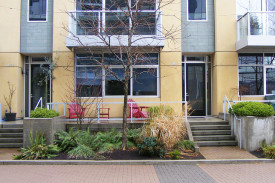
Pink Chairs, South Waterfront (Portland) by Dan Reed used under CC BY-NC 2.0
Housing built around courtyards or rowhomes are wonderful because you have semi-private outdoor space but it’s dense enough. Places in Seattle like Ballard and Lower Queen Anne and Capitol Hill are all dense enough to support a mixture of uses. It’s not that you need fifty-story high rises to support family-friendly density. It can be comfortable and still feel like a residential mixed-use neighborhood.
Q: What is the range of experiences for families that choose to live in downtowns?
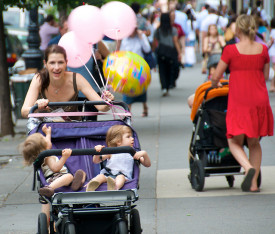
Hold on, kids: It’s starting to rain and we gotta run for home! (New York) by Ed Yourdon used under CC BY-NC-SA 2.0
A: Many parents who live downtown say it’s wonderful because there are X number of kids in our building, and the alternative to that that was families who were kind of the lone ranger in the city and who ended up driving to all their playdates. I heard this from a lot of families in Seattle: “We love living downtown but if we ever want our child to interact with other kids, we have to drive somewhere.” So that tipping point with kids is really important.
There are parents who are going to live downtown no matter what, and they’re going to figure it out. But what I heard from many parents who had left the urban core was that it wasn’t one particular thing. It was all the little things. It was the homeless guy who exposed himself to my son and the fact that our neighborhood was noisy. But you also run into those same little things once you move to the suburbs, where some families found life was pretty isolating.
Q: How important is having a public school in a city’s downtown core?
A: Whether you have a good school in your neighborhood was huge. Middle income parents in particular are willing to go to a lot of trouble to ensure their kids have what they see as a good education.
To give you one story, which kind of knocks my socks off, this woman in Chicago lived in a condo on the North Shore and commuted 25 minutes to her job downtown. She felt better about having her kids in a daycare near her in a downtown daycare so they all rode the train in with her. Then a magnet elementary school opened up downtown and was doing well, and they wanted their son to go there. But by the time he was of school age, it had been turned into a neighborhood school. They ended up renting an apartment just to have that address so they could send their son to this downtown school.
I think that highlights two things—one is the expense that some parents are willing to go to and it also highlights the power that redistricting and school assignment policy has.
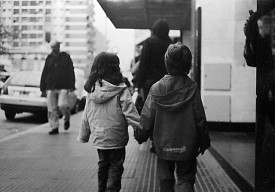
Juntos by Federico Casares used under CC BY-NC-SA 2.0
Q: Can you talk a little about the difference between trying to create a safe vs. risk-free experience for kids as they grow up?
A: No one wants children to get hurt, but certainly I think in the US we are such a litigious society. Unlike waterfronts in other countries, we have railings everywhere and we’re very risk-averse, I think to the detriment of being able to grow and learn what risk is. You may encounter some risk with children learning to navigate city streets and traffic, but navigating a bus system or learning how to ride light rail gives a child an independence that he or she may not get until they have a driver’s license living in the suburbs.
Kids growing up in cities also learn to engage with people of different ages and incomes, as opposed to only interacting with their family network and school network. I think they learn to handle situations with strangers, and it just enhances confidence. Now there are examples where there are negatives, certainly, but there are also negatives to suburban living.
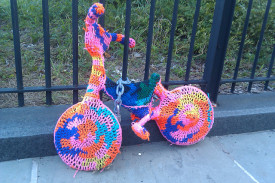
Yarn Kids Bike DUMBO NYC by Brian Russell used under CC BY-NC-SA 2.0
Q: What innovative things have other cities done to draw families with children out of single-family neighborhoods?
I think the family-friendly parks and really interesting playspaces—not just slapping up a swingset but making it an enjoyable place for parents and children and young people and the elderly. Teenagers, in particular, are a really tough crowd. Brooklyn Bridge Park just has these wonderful amazing playgrounds and volleyball courts and programming in and around the old piers. But Chicago and New York have always had kids living downtown so that’s a little different.
For cities that kind of lost that—Seattle and Denver are very similar—the school boards sold off their urban properties, and now there are kids downtown. It’s harder there. But quickly setting up a temporary school in a building to see if that actually attracts people and using that as a landing pad and building on it is a great way of doing it.
Q: What would be your top recommendations for making Seattle’s downtown core more family-friendly?
A: The first would be to create an elementary school downtown. I think it’s a great first step that will help flesh out some of the other issues. The second is getting an organization of parents to advocate for families downtown. I really like the idea of a family village overlay zone centered around schools. Families with kids don’t need to be everywhere, but focusing around schools is a good way to aggregate that. Planning bike infrastructure as if children were actually going to use it would be a good start. The bike lane on Second Avenue is a nightmare even for advanced cyclists.

Under the Crown Fountain (Chicago) by Rachel Pasch used under CC BY-NC 2.0
Q: Which of the cities you visited felt the most family-friendly?
A: I love Vancouver, BC, but it’s too expensive. I actually think Chicago—I would live in one of Chicago’s urban neighborhoods in a heartbeat. Certainly its downtown is dense, but the dense first suburbs with the six-story apartment and brownstone buildings have a nice wonderful feel. The parks are really well integrated, you’ve got great transportation, and the path along the waterfront and lake is great.
Minneapolis was a really cool place to visit, and they have a neighborhood kind of like Capitol Hill that is seeing a lot of development, and they have this amazing off-street bike network. Denver does as well. But Seattle is the densest of those by far, so they’re winning the game there. It’s kind of all these little pieces that have to come together, with schools and family-sized housing and the ability to get around without a car being at the top of the list. I don’t know that any city has all the puzzle pieces completely together.
Note: Sarah Snider Kompaa is an urban designer now living in Denver. Her family-friendly research was made possible, in part, by the 2012 Seattle American Institute of Architects (AIA) Emerging Professionals Travel Scholarship.

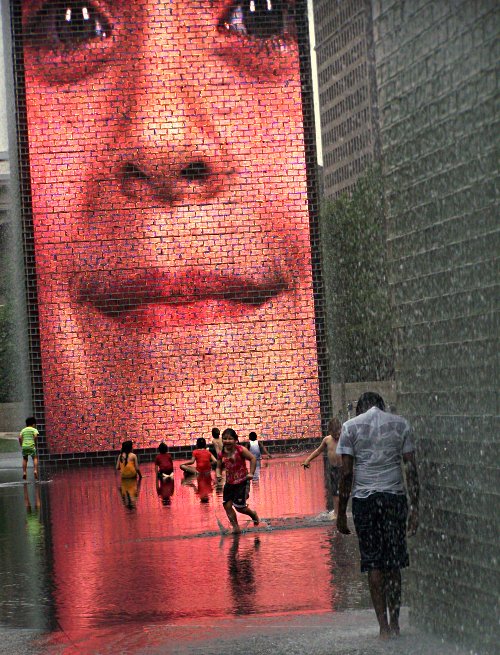
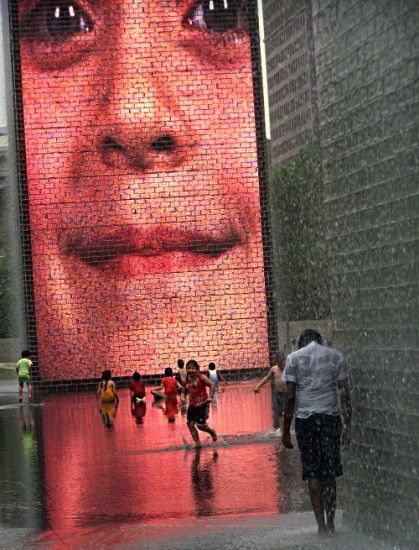
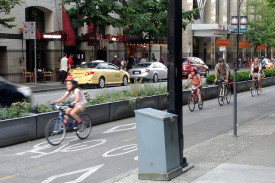
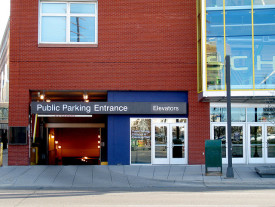







Sean P.
Jennifer
Seattle Public Schools has levy in place for nearly three quarters of a billion dollars worth of infrastructure and technology improvements to existing schools: http://bex.seattleschools.org/bex-iv There are many existing schools where kids can’t drink water from water fountains due to existing pipes being tainted by lead. The idea of a downtown school, mentioned in this interview, seems to be building momentum recently, but how is one more poorly maintained school going to be an “ingredient for a pro-kid” city? It’s great for an urban designer who doesn’t live here to come in and say “build this” but it’s another to live here and look at the big picture of public education, which includes the maintenance issues I mentioned, capacity issues in parts of the city other than downtown, and administration issues like the revolving door of superintendents. I guess what I’m trying to get at is that the idea of building a new school downtown for future kids would be shortchanging the kids who are already here. SPS has never shown a talent for demographic prediction so if they are in any way involved with projecting downtown school usage, I’d be wary of what they say.
Jennifer Langston
Schools are a huge issue, and one that I’ll be covering in more depth. But there are some parts of downtown Seattle/South Lake Union/Chinatown-ID that have seen significant growth in the number of kids living there, especially those under 5. That’s not based on SPS projections but Census data.
So the downtown school wouldn’t be to accommodate mythical “future” kids but the ones who are already living there and who are or would arguably be shortchanged by getting shipped up to Queen Anne or Capitol Hill.
Seattle is also one of the very few major cities in the country that doesn’t have a public elementary school downtown to serve families in the urban core. Portland and Vancouver, for instance, both do.
Sean P.
I think we’re talking past one another; those kids in the under 5 age group you mention? They don’t exist yet to SPS because the district is in crisis mode all the time–they can’t plan one year in advance, much less 4-5 years. They haven’t figured out what to do with the capacity issues for middle school kids ALREADY in the district or the same issue when it hits the high schools in 2-3 years. So kids not in the system are likely not even on their radar. Nor do I believe they use Census data for their demographic projections, even though that’s a logical thing to do. Your assumptions about population growth are logical, but you’re dealing with a district that has proven nearly impervious to logic. Hence my reluctance to spend more money on something new when existing needs are so dire.
Jennifer Langston
That seems like a good argument for helping SPS anticipate where future growth is actually going to occur and planning accordingly, not for maintaining the status quo.
Sarajane Siegfriedt
I’m not defending SPS, but there has been steady growth since 2007, now amounting to 1,500 students–three whole elementary schools per year, with no additional capital funds from the state. There are so many classrooms in aging portables that they have run out of playground space to put them. Much of this growth is in the North End. Capacity issues are a year-to-year unfunded battle. Decreasing class size or adding universal all-day kindergarten will create huge additional pressure. I hope no one thinks universal pre-K will be housed in school buildings.
Mark-in-seattle
As I type this our North Ballard neighborhood, living around Loyal Heights Elementary School, is at war with the SPS Central Office construction project management staff and consulting army. They have ignored the majority of parents and residents who want LHES to be remodeled with a reasonable enrollment growth capacity, but still keep the current basic 3 classrooms per grade model instead of the mega-school SPS wants to shoehorn into the 2.8 acre LHES site, one of the smallest in all of Seattle. The SPS design will cut the playground to 1/2 it’s current tiny size (half a soccer field) while potentially doubling the number of students with flex classrooms filled even using the smaller class size model.
This is an ugly battle that SPS is very good at waging, just ask other parent groups in the northend who have been steamrolled so far: Thornton Creek, Laurelhurst…etc.
SPS enrollment projections are demonstrably incompetent. They entirely missed the northend student increase during the Great Recession (kids coming out of private school into the public schools was one factor). So now they insist on fighting the last war by projecting huge yearly enrollment increases, but as per usual can’t explain how their numbers were wrong again in Fall of 2015 with an UNDER-ENROLLMENT of 840+ kids from what they advertised as “conservative projections”. Some upset citizens fought SPS to obtain raw enrollment data via a public information filing, but the dept stonewalled for 6 months. Even the SPS legal dept was upset with the enrollment dept foot dragging. Parents from LHES looking at the eventually released data have discovered SPS’s own enrollment projections thru 2025 show several years of enrollment decline for LHE then leveling off to maybe a modest +4% gain if left to organic in the neighborhood growth (North Ballard is not a condo canyon like central Ballard).
SPS solution – to justify the mega-school model, they are going to bus kids in from a neighboring elementary school: Whittier Elementary to fill the mega school. We believe the LHES principle and teachers have been promised lots of extra dollars will follow along with the new bused students who are from lower income homes and trigger higher per/student district allocation dollars.
SPS Central Office wants to spend BEX IV capital funds in the most wasteful manner possible – huge budgets for a handful of schools. Example: LHE’s budget is $43-million and climbing, now $11 million over the original budget, while neighboring schools: North Beach Elementary, Adams Elementary, Whittier get effectively nothing and must wait their turn for 5+ years until money flows from BAT & BEX-V ..etc. $43-million for an enrollment increase of only 220 students if you believe SPS’s own number, which we do not, all bused in because the LHE neighborhood is growing only very slowly if at all: Baby Boomers like me are staying in their homes at much higher rates than were projected, fewer large homes available in the area for new young families. All of these facts are ignored by SPS, because maximum BEX-IV spend that insures BEX-V … BEX-VI…. BEX-VII… keeps their office headcount stable or increasing regardless of what the legislature ever does. The perfect gravy train.
The parents at LHES want to share the $43-million with all the other schools, so each gets an appropriate smaller remodel, not the mega model but SPS Central Office wants none of that, because in my analysis, with State education dollars in historic decline the SPS-CO staff has come to depend on gerrymandering perennial big capital budgets to cover a larger part of their own headcount. The staff always wants the job of upgrading Seattle Schools unfinished so that every 3 years they can demand another $600 million capital levy spend from the public. It is a rigged game by design, pitting school communities against each other, divide and conquer – worked for the British Empire.
SPS Central Office is one of the most feared and reviled local bureaucracies. You take them on at your pearl. Neighborhood activists at Thorton Creek told me SPS said if they continued to fight the mega-school project SPS would use eminent domain to purchase several homes to use for required on-site parking or a bus-loading zone…. I am not making this up. You fight SPS in the traditional way and you are going to lose and have a long time to treat your wounds.
Mike Lanza
Thanks for this article! I’ve written a book and blog about kids, neighborhoods, and play called Playborhood (http://playborhood.com). One neighborhood I identified as outstanding for kids is on Dibble Avenue in Ballard (http://playborhood.com/2011/11/frank-the-builder-builds-community/). You should really check out their “Nibble on Dibble” this year – it’s usually one weekend in August.
One slight difference I have with this article is that parents should be basing their decisions on not just neighborhoods in big cities, but *all* neighborhoods. There’s an extreme bias these days against suburbs, but some of the best neighborhoods in the US for kids are in suburbs – not the far-out exurbs entirely created for cars that are so easy to ridicule, but more established suburbs that are great for walking and biking, but also have space for kids to play.
I write about many neighborhoods, from urban to rural. My favorite urban spots for kids in North America are small pockets in Seattle’s Ballard neighborhood, Portland’s Sellwood neighborhood, the Beaches neighborhood of Toronto, and the South Bronx (yes!). But there are so many others outside of big cities!